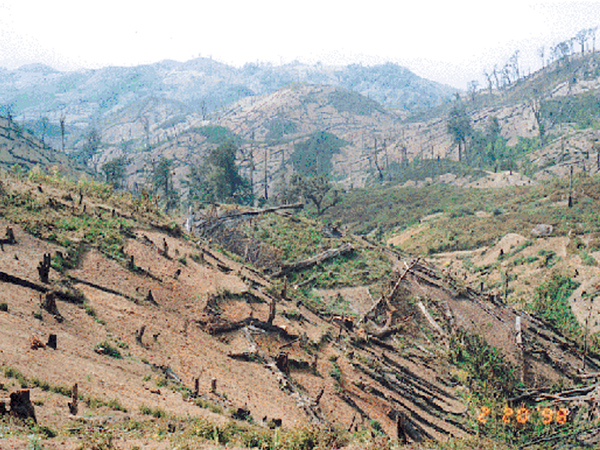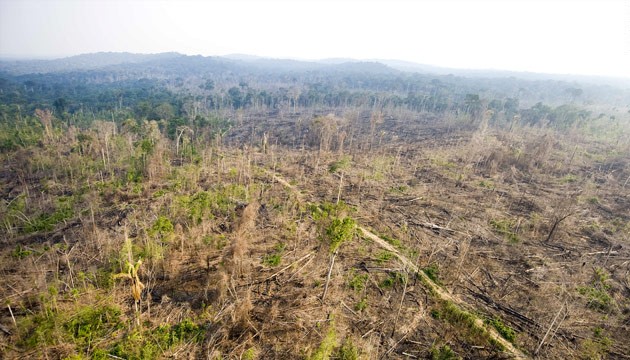Over the years, Nepal, a once widely forested nation has succumbed to extensive deforestation. The mountain region of Nepal is home to two thirds of Nepal’s population, leading to harsh demands on the land. These issues have not only created an ecological imbalance, but have also caused economic hardships for the people of Nepal. By the 1990s, forest resources had decreased by 75% despite Nepal’s forestry programs (Regmi 73). Because forests in Nepal are located on top of steep slopes, the country is more susceptible to severe damage following natural disasters. After the earthquakes, the country’s extensive history of deforestation contributed to severe landslides in Nepal. Along with the environmental effects, poverty among rural Nepalis has led to a complicated relationship between the people and the land.
Deforestation’s Effects on the Landscape
The negative effects of deforestation are cumulative. Deforestation contributes to flooding because tree roots hold the soil in place, preventing sediment from traveling (whyfiles.org). Similarly, tree roots absorb more water than grasslands, so the surrounding soil is drier and able to store more water when it rains, thus inhibiting flooding. Without tree roots, eroded soil can end up in river beds, reducing a river’s ability to hold water and making them more susceptible to flooding. When earthquakes occur where there are steep slopes, which are plentiful in Nepal, the soil slips, causing landslides (people.uwec.edu). The earthquakes sparked numerous landslides in Nepal, which were provoked by a long history of deforestation, making their aftermath even more devastating and difficult for aid workers to reach those in need.
Deforestation’s Effects on the People
Poverty’s Role in Deforestation
Even before the 2015 Earthquakes, poor Nepalis were greatly dependent on the wood drawn from their forests. “In Nepal, about 66 percent of households use wood as the main fuel for cooking,” while 13% and 8% use kerosene and LPG, respectively (Pant 1169). Over 89% of total energy use in Nepal comes from traditional fuels, as electricity and kerosene are only accessible in more urban areas to a small number of people (sandeeonline.org). The cost of fuel causes many impoverished Nepalis to rely on wood from forests to provide food and warmth for their families, leading to additional deforestation. The 2015 earthquakes damaged over 600,000 houses, leaving many Nepalis homeless and in need of wood to help rebuild their houses (www.pri.org). Consequently, Nepal’s government has been allowing deforestation, in an attempt to balance forest conservation with providing the people with resources.
Health Effects of Deforestation
Cooking food using traditional, inexpensive biomass fuels, like the wood collected from deforestation, leads to indoor air pollution. Women and children, who are more likely to cook, are more susceptible to respiratory illnesses (Pant 1169). The rural poor usually ignore or are unaware of the health risks of using biomass fuel, which allows this practice to continue (Pant 1170).
What can be done to address post-earthquake deforestation related issues?
Policy development
- The Nepalese Government should continue to institute policies that alleviate poverty as a way to decrease deforestation.
- These policies would address the balance needed between conservation and provision of this affordable fuel.
Community forestry
- The process of adapting forestry and forest management to make it more sensitive to the interests of rural people with a stake in forests (FAO).
- Puts the villagers in charge of the land, which improves livelihoods.
- Reduces the practice of deforestation and thus further stabilizes the land to better withstand earthquakes and flooding.
Who is currently working on these issues?
Nepal Swiss Community Forestry Project (NSCFP)
- Switzerland-based organization that has been supporting the implementation of community forestry programs (forestrynepal.org).
- Works with Nepal’s government to encourage policy development.
- Policies aim to improve the livelihood of the poor and reduce pollution, mitigating the health effects of consistently using wood as fuel for cooking.
Nepal has been leading the world in community forestry. The government is working to protect the forests and improve the social equity of those who depend on them.
The Forest Act (1993)
- Called for the handing over national forests to local communities.
- Allows community forestry users to control how forests are managed (worldbank.org).
The Master Plan for the Forestry Sector (1989)
- Aims to fight the effects of deforestation as well as poverty.
- Encourages sustainably conserving forest resources and balancing the supply and demand of forest products.
- Creates income and employment opportunities for impoverished Nepalis (Colfer and Dahal 66).
Next Page (Monsoons)
Resources used (not hyperlinked)
Colfer, Carol J. Pierce., Ganga Ram. Dahal, and Doris Capistrano. “Community Forestry in Nepal: Decentralized Forest Governance.”Lessons from Forest Decentralization: Money, Justice and the Quest for Good Governance in Asia-Pacific. London: Earthscan, 2008. 65-79. Print.
Pant, Krishna Prasad. “Valuing Interventions to Reduce Indoor Air Pollution- Fuelwood, Deforestation, and Health in Rural Nepal.” The Pakistan Development Review 46.4 (2007): 1169-187. Print.
Regmi, Rishikeshab Raj. “Deforestation and Rural Society in the Nepalese Terai.” Occasional Papers in Sociology and Anthropology Occ.Pap.Soc.&Anth. 4.0 (2008): 72-89. Web.




